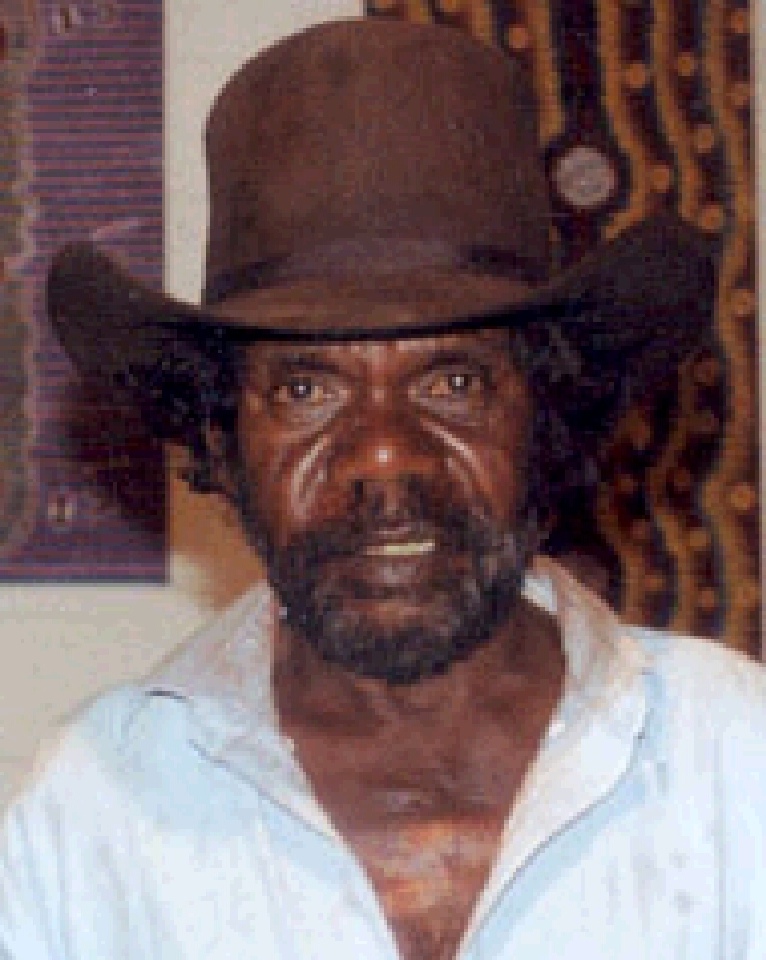Maxie Jampitjinpa

DOB:
c. 1945 - 1997
Born:
LANGUAGE GROUP: Warlpiri/Luritja
COMMUNITY: Haasts Bluff, NT
Maxie Jampitjinpa, a respected Warlpiri man, has been described by one leading writer on Aboriginal art as the ‘Minimal Mythologist’. At the time of his death in 1997, he enjoyed a growing reputation as the leading innovator in desert art.
During the early 1990’s, artists of his generation became more secretive about revealing their Dreamings to an increasingly inquisitive band of buyers who wanted to know 'the stories'. This was one, but not the only, factor which led Maxie to develop his so-called 'telephone booth' style. This style was characterised by an all-over flicked mark which departed radically from the tight Papunya manner in which he had been trained. There were no focal points and no clear-cut symbolism in the accepted desert manner.
His status as an innovator is enhanced however, when we learn that Maxie had painted similar canvasses some six years earlier. 'Flying Ant Dreaming' for example, consisted simply of layers of yellow and red ochres and white clay stippling on a black ground. This was Maxie’s response to concerns about the recognition of his painting as art opposed to it being something anthropologically obscure, derived from the images and forms of ceremony.
It has become clear in recent years that second generation painters such as Maxie have followed a path away from the traditional one established at Papunya in the decade after 1971. They have developed their art as a personal reaction to their country and have modified aspects of their Dreamings to accommodate the perceived necessity, in the market place, for a more individual and painterly style.
For the painters their Dreamings will always remain their true 'signature', but dealers, collectors and curators have increasingly requested works which may be easily linked to a given artist. Many painters, Maxie included, have several painting styles which are peculiarly theirs.
Maxie Jampitjinpa was born in Haasts Bluff, 230 kilometres west of Alice Springs, about 1945. He was part of the Warlpiri group, his father's traditional country was Watunuma in Warlpiri territory, and his mother was of mixed Warlpiri/Luritja descent. These areas are near Waite Creek.
During his mid-teens Maxie's family moved away from Haasts Bluff to Papunya so that the children could attend the school at the government settlement there. As a young man during the early 1970's, however, Maxie spent much of his time away from Papunya. After enrolling in a health workers course in Darwin, he worked at various labouring jobs which provided him with a broad spectrum of experiences of mainstream Australian culture. Maxie later found that such experience, when combined with his deep knowlege of traditional living, provided him with a range of basic premises on which to base his life and art.
After his move back to Papunya in the late 1970's, he worked as a tractor driver, bus driver and police tracker. He began to paint in 1980 under the expert instruction of Old Mick Jackamarra, one of the pioneering 'painting mob' who had worked with Geoff Bardon in 1971/72. Old Mick, the senior Warlpiri lawman in Papunya at that time, passed on his passion for painting to Maxie and soon realised that his pupil had a natural ability to paint and tell the Dreamtime stories. Maxie's usual subjects included the Flying Ant Dreaming and Woman's Dreaming as well as the Bushfire Dreaming. Other influential artists in Maxie's development included the artist sisters Eunice and Pansy Napangardi with whom he worked.
Maxie's first claim to fame was not particularly pleasant for this quiet man, as his victory in the contemporary art section of the $50,000 Northern Territory Art Awards in 1984 set the stage for a bout of controversy. Local non-Aboriginal artists were disturbed by his win, considering his art to be 'folk art', not 'fine art'. They also considered themselves to be excluded from Aboriginal art competitions, arguing that the contemporary art section of the competition was an open competition and not culturally specific. In effect, Maxie's 'Happenings at Leibig' made a major contribution to the opening up of the art scene, to include Aboriginal art in major competitions around Australia.
However, this important win enhanced his reputation as one of the leading artists of the Aboriginal art movement. Numerous subsequent exhibitions have displayed his development and contribution to the movement; he has exhibited throughout Australia and internationally since the mid '80's. For the last decade of his life the painter was based in Alice Springs where he developed and refined his flicked style of background infilling, which now has many imitators, although none of them have been able to match his expertise.
Later works of Maxie's have been compared with some works of the late Emily Kame Kngwarreye - similarities being recognised in the technique of paint application, style and apparently abstract notions with areas of colour devoid of conventional dotting or accepted elements of Western Desert iconography. Similar questions are asked, 'Is this Aboriginal art?' The point here is that painters of the ability of Emily and Maxie have 'broken the mould' and have projected Aboriginal art-making to a new level.
